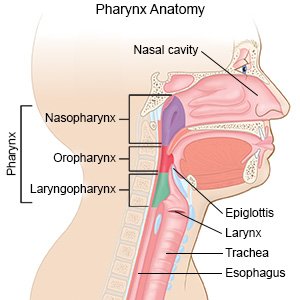Foreign Body in the Pharynx
Medically reviewed by Drugs.com. Last updated on Aug 4, 2025.
AMBULATORY CARE:
A foreign body in the pharynx
is an object that gets stuck in your child's throat. Examples include small toys and pieces of food. Your child may choke on the object if it blocks his or her airway. This can be life-threatening.
 |
What to do if your child is choking:
Call your local emergency number (911 in the US) if your child cannot breathe or is not conscious.
- Do CPR if your child is not conscious. Wait for help to arrive if you do not have training.
- Do the Heimlich maneuver (abdominal thrusts) if your child is conscious. This may help push the object out. Wait for help to arrive if you do not have training.
- Allow your child to try to cough the object out. Your child's airway is not fully blocked if he or she can breathe and talk. A strong cough may help push the object out. Do not pat your child's back or reach into his or her mouth to try to grab the object. These could push the object farther down the airway.
Common signs and symptoms include the following:
- Choking, coughing, or trouble swallowing
- Sore throat or hoarse voice
- Shortness of breath or wheezing
- Drooling in older children or more drooling than usual in babies
- Not being able to breathe, talk, or make noise
Call your local emergency number (911 in the US) if:
- Your child was choking and is not conscious.
- Your child is choking and cannot breathe, talk, or make noise.
- Your child's lips are turning blue.
Seek care immediately if:
- You think or know your child swallowed a magnet or button battery.
- Your child cannot stop drooling or is drooling more than usual.
- Your child has trouble swallowing.
- Your child cannot stop coughing, choking, or wheezing.
Call your child's doctor if:
- Your child has a fever.
- Your child has blood in his or her saliva.
- Your child does not want to eat because it hurts to swallow.
- Your child has a hoarse voice.
- You want information about organizations that offer CPR or Heimlich maneuver training.
- You have questions or concerns about your child's condition or care.
How an object in your child's throat may be found and removed:
Your child's healthcare provider will examine your child and ask about his or her symptoms. Tell the provider if you know what the object is or if you tried to remove it. Your child's provider may use any of the following to find or remove the object:
- An x-ray may show an object in your child's throat.
- A scope may be used to find or remove the object. A scope is a bendable tube with a light and camera on the end. The scope may also be used to remove the object.
- Surgery may be needed if the object cannot be removed another way.
Prevent another object from getting stuck in your child's throat:
- Make food easier for your child to eat. A child may choke on foods such as hotdogs, French fries, or hard candy. Do not give your child large chunks of food. Mash the food, or cut it into pieces that are the right size for your child's age. Your child's healthcare provider can give you more information.
- Have your child sit while he or she is eating. Have your toddler sit on a high-chair or booster seat with a strap, if possible. A booster seat allows your toddler or young child to reach food on the table and eat safely. Do not allow your child to run with food in his or her mouth.
- Avoid distractions at mealtimes. Do not let your child watch television or play if he or she is eating. Your child may try to talk or laugh and start to choke. Give your child enough time to eat and drink. Remind your child to chew food well before he or she swallows.
- Keep small objects out of your child's reach. Examples include magnets, button batteries, and toys with small parts. Check toy packages for warnings about choking risk in young children. Do not give your young child any toy that has small parts that come off easily or are broken. Put small household items high up in hard-to-reach places. Check your home often for objects your child can reach and choke on. Look for objects on the floor and under furniture.
Follow up with your child's doctor as directed:
Write down your questions so you remember to ask them during your child's visits.
© Copyright Merative 2025 Information is for End User's use only and may not be sold, redistributed or otherwise used for commercial purposes.
The above information is an educational aid only. It is not intended as medical advice for individual conditions or treatments. Talk to your doctor, nurse or pharmacist before following any medical regimen to see if it is safe and effective for you.
Further information
Always consult your healthcare provider to ensure the information displayed on this page applies to your personal circumstances.
